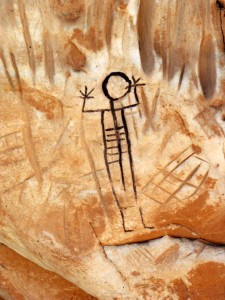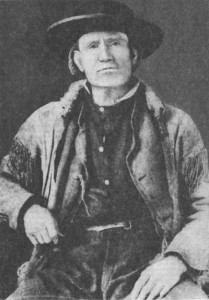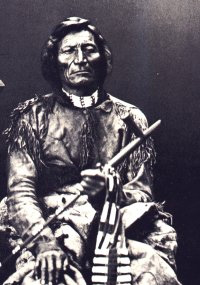The Kaycee area in the modern era was occupied by the Crow Indians, but pressure from white settlement from the East pushed other tribes, such as the Sioux and Cheyenne, into the area as well. Evidence of the natives can still be found today.
The first record of white men to the area was a party of fur traders led by Wilson Price Hunt traveling westward in 1811. The party was organized by John Jacob Astor, the famous tycoon, in an attempt to expand his fur trade empire to the West coast. It seems they followed the Powder River to Middle Fork before crossing the mountains. [i]
In 1834, Antonio Montero, born in Portugal, established a trading post eleven miles east of Kaycee, which became known as the Portuguese Houses. It was solidly built of hewn cottonwood logs, and according to Jim Bridger, withstood a siege by the Sioux for 40 days. However, the economic viability of the post could not withstand the mischief of the 300 men of the American Fur Company led by Bridger who camped nearby in the winter of 1836-1837.[ii] This was most likely an attempt by Bridger to drive Montero out of the fur trade by trapping and killing all the beaver in the area.[iii]
Montero left the area shortly thereafter, and there was little left of the fort when Bridger and Captain W.F. Raynolds stopped by the site in 1859. [iv]
That same year (1859), Captain Raynolds, with Jim Bridger as his guide, came through the area making a map and gathering information to report toCongress on the disposition of the Indians, wood, water, wildlife etc. Bridger also provided the Indian names of all the rivers and creeks. [v]
In 1863 John Bozeman and John M. Jacobs[vi] marked out a shortcut to the Montana gold fields right through the Indians best hunting grounds. The trail, known as the Bozeman Trail, went within four miles of Kaycee for a three year period.
Thousands of immigrants traveled this road and to help escort them safely, Fort Reno was built by the US military at Powder River Crossing in 1865. When war with Indians escalated in 1867, the military was forced to abandon the Bozeman Trail and the forts located along the way. Abandoned in 1868, Cantonment Reno would be re-built three and a half miles upstream from the old fort in 1876. [vii]
Less than ten years later, after a relentless war against the Plains Indians by the U.S. government under General Crook, the final defeat of the natives took place 25 miles west of Kaycee in the Red Fork Valley. In the pre-dawn hours of November 25, 1876, a large village of Northern Cheyenne Indians, many of them victors from the Battle of the Little Big Horn, were attacked by US soldiers led by Colonel Ranald MacKenzie. The braves held off the soldiers long enough for the women and children to flee into the mountains, where many perished from the cold conditions. The village was burned and most of the Indian ponies were killed.
[i] Hanson, Margaret Brock, Powder River Country: The Papers of J. Elmer Brock, p. 11
[ii] Hanson, Margaret Brock, Powder River Country: The Papers of J. Elmer Brock, p. 11
[iii] Rea, Tom, The Hole in the Wall Ranch: A History, p. 47-48
[iv] Hanson, Margaret Brock, Powder River Country: The Papers of J. Elmer Brock, p. 12-14
[v] Hanson, Margaret Brock, Powder River Country: The Papers of J. Elmer Brock, p. 14
[vi] Hanson, Margaret Brock, Powder River Country: The Papers of J. Elmer Brock, p.19
[vii] Patrick, Anna and Louise Turk, The Powder River Historical Loop, p. 5-6



